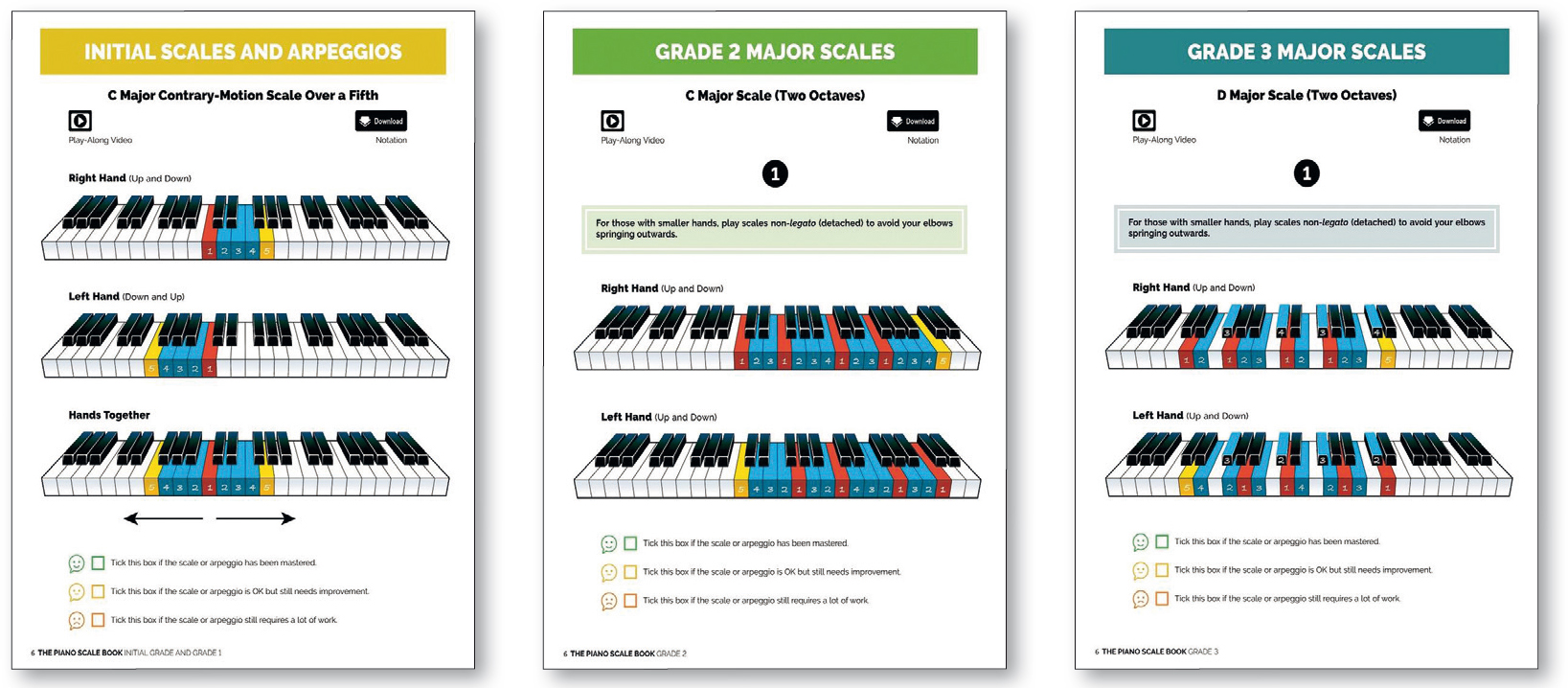
As teachers, our own relationship with scales will surely impact on how we ‘sell’ them to our pupils – are they just a necessary evil, a hoop to jump through for exams? A means of working on technique? Or an integral part of understanding how music is constructed, with the added benefits of aiding pattern recognition, sight-reading, improvisation and aural skills? While all three probably apply, a healthy approach to scales should explore their necessity to the development of broader musical understanding and skill.
I am always keen to try any new resources that might make the process of learning the fingering patterns for scales easier on my pupils, so The Piano Scale Book series – with its colourful diagrams – immediately appealed. The first book covers both Initial and Grade 1, with separate volumes each for Grades 2 and 3. Within each volume, the scales included cover the requirements of the four major examination boards – ABRSM, Trinity, LCME and MTB – and include natural, harmonic and melodic versions of the minor scales at Initial, Grade 1 and Grade 2, and the harmonic and melodic versions at Grade 3. Scales for further learning at the end of each volume explore the pentatonic, whole-tone and modes, extending learning beyond that of the exam boards.
The books include large colour keyboard diagrams of each scale, with the keys played by the thumb coloured red, the main ‘blocks’ coloured blue and the finger 5 key coloured yellow. This makes the fingering for each scale very clear and would be especially helpful for visual learners and younger children. Associated with each scale is a video and PDF document of notation (also colour-coded) for download via the Hal Leonard website – useful resources, although QR codes would perhaps have been more convenient. The accompanying videos use a sliding-coloured tile method (familiar to many young pianists from YouTube tutorials) to demonstrate the scales, played both in blocks and as separate notes.

I tried out the Initial/Grade 1 and Grade 2 books with pupils aged between 7 and 14, who all enjoyed the approach and found it easy to understand. One concern arising from my perspective was that the blocks, or clusters, of notes made it harder for pupils to hear their mistakes. One pupil happily played G major with missing F sharps and did not notice there was anything amiss until he played the scale as separate notes. Certainly, the note clusters tend to reduce the clarity of the scalic structure. Pupils could practise incorrectly if they use the blocks method alone for any length of time.
Of greater concern is that the method reduces understanding of the scale – the position of tones and semitones and how these relate to the key signature – via its focus on fingering patterns. While a skilled teacher can make use of the digital resources to teach more holistically, using the score as a separate resource makes it likely that pupils will simply learn the scale from the coloured keyboard charts. This becomes particularly detrimental in minor scales such as C harmonic minor, in Grade 3, when the raised 7th degree, B natural, becomes ‘invisible’ by looking solely at the keyboard diagram.
When trialling the Grade 3 book with a pupil, other issues became apparent. For example, in E flat major and F sharp minor scales, the blocking system seems less clear and helpful, with some keys on the diagram not assigned a colour and the block itself only involving two black keys, impeding the visual representation of the layout of the scale on the keyboard. Chromatic scales were another issue; the coloured keyboard diagrams do not fully lend themselves to this small repetitive pattern.
In summary, while The Piano Scale Book represents a useful visual resource for learning scales by rote and consolidating patterns of fingering, it does not provide a comprehensive, holistic method for teaching scales in a way that facilitates the development of musical knowledge and understanding. I would have liked to see the music notation in the book itself, alongside the keyboard diagrams, to facilitate the recognition of scale and arpeggio patterns in notation as well as on the keys. In an ideal world, good use would be made of the accompanying digital resources, but in reality, pupils often don’t access online resources, and printed copies would be inconvenient. That said, provided a pupil understands the scales and key signatures, I can see a role for the colour block system in helping with the reinforcement of fingering patterns, or indeed helping those who, for whatever reason, cannot or do not wish to engage with music theory and are satisfied with learning scales and arpeggios by rote.




